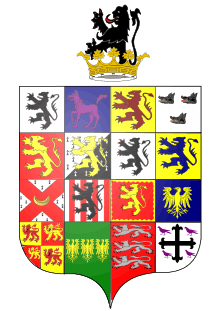Hughes of Gwerclas
Hughes of Gwerclas were a native Welsh royal family descended from Owain Brogyntyn the illegitimate but acknowledged son of Madog ap Maredudd (one of the last kings of Powys, of the House of Mathrafal) by a daughter of the "Maer du" or "black mayor" of Rûg in Edernion. His father granted to him and his successors the Cantref of Edeyrnion and the Lordship of Dinmael. These areas were both remote frontier lands situated between Powys and the neighbouring ascendant kingdom of Gwynedd. From the earlier part of the 12th Century both lordships usually paid homage to Gwynedd.[1]

Owain had three sons. It is from the youngest of these sons, Iorwerth ab Owain ap Madog ap Maredudd, that the barons of Cymmer yn Edeyrnion claim descent. Iorwerth's son, Gruffudd ab Iorwerth, was confirmed in his lands by Edward I in 1284. The first recorded use of the Kymmer yn Edernion baronial title is by Owain ap Dafydd (great-great grandson of Owain Brogyntyn) in 1334 who resided at Plas Uchaf in the parish of Llangar, Merionethshire (in that part of the county historically included within the cantref of Edeyrnion). The family started using the surname "Hughes of Gwerclas" after Hugh ap William in 1546. Thomas Hughes, "Esquire of Gwerclas and Hendreforfydd" is recorded as having served as a captain under the Royalist standard for Charles I and died in 1670. His third and only surviving son John Hughes married a descendant of Ednyfed Fychan. John was succeeded first by his brother Hugh, and then his son Daniel. Daniel married Catherine daughter of John Wynn "of Pen y Clawdd". He died in 1754 and from this time the Hughes of Gwerclas resided at Pen y Clawdd, thought to be in the vicinity of Chirk in Flintshire.
In 1851 the XVIIIth Baron of Kymmer yn Edernion is recorded as being William Hughes Esq. (b. 1801 at Pen y Clawdd). He spent a long time living at Gayton Mansion in Northamptonshire. In the 1851 National Census of England and Wales he, along with his wife, children, and domestic servants are recorded as living in Twyford, Hampshire. He contributed to antiquarian debate and was employed as a barrister at the Inner Temple. His only son, William O'Farrel Hughes, was still living in 1911 but by then a 73-year-old retired clergyman with no children. His cousin - Lieutenant Talbot de Bashall Hughes (b. 1836) - had joined the Cape Mounted Riflemen in the 1850s and disappears from the record. It is possible that he may have died in South Africa during the Anglo-Zulu Wars. The Barony of Kymmer yn Edeirnion is currently dormant, as it is uncertain whether there are any living descendants of the Hughes of Gwerclas family.
"Few families can establish a loftier lineage, or deduce their descent through more numerous stocks of historic distinction, than the Hughes of Gwerclas, Barons of Kymmer yn Edeirnion, within the ancient Principality of Powys and Kingdom of Wales. Derived, by uninterrupted lineal male succession, from Owain Brogyntyn, Lord of Edeirnion, Dinmael and Abertanat in Powys, son of Madoc, last Sovereign Prince of Powys, the existing heir of the Hughes's deduces, through the Baronial Lords of Kymmer, and the Royal Line of Powys, a genealogy of twenty eight descents, extending over ten centuries, transmitted in common with the lineage of the monarchs of North Wales and South Wales, from Rhodri Mawr, renowned in the annals of the Cymri as the Egbert of his race, who, uniting the several states of North Wales, South Wales and Powys, became King of all Wales, AD 843."
Burkes Landed Gentry, 1850, p.603
Footnotes
- The Royal Tribes of Wales, pg. 120
References
- The Royal Tribes of Wales, Philip Yorke, London (1799),
- The Royal Families of England, Scotland and Wales, John Bernard Burke (1851), vol. 1, pedigree L11
- A Genealogical History of Abeyant, Forfeited, and Extinct Peerages of the British Empire, by Bernard Burke, John Burke, Published by Harrison, 1866, Oxford University